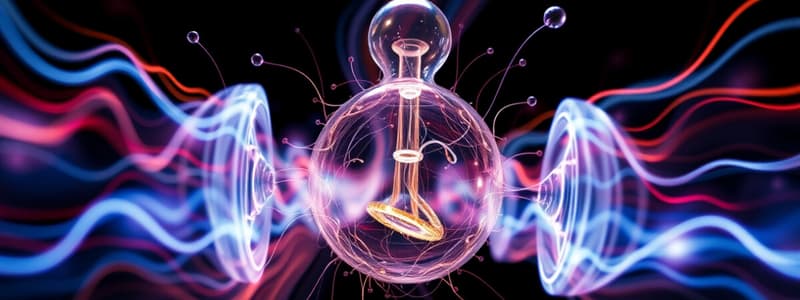Podcast
Questions and Answers
What creates magnetic fields?
What creates magnetic fields?
- All forms of energy
- Static electric charges
- Moving charges (correct)
- Magnetic materials
Which principle states that time and space are relative?
Which principle states that time and space are relative?
- Quantum Mechanics
- Classical Mechanics
- General Relativity
- Special Relativity (correct)
What does the equation W = Fd cos(θ) represent?
What does the equation W = Fd cos(θ) represent?
- Work (correct)
- Energy
- Power
- Momentum
Which SI unit is used to measure electric current?
Which SI unit is used to measure electric current?
In an isolated system, which property is conserved according to the principles of mechanics?
In an isolated system, which property is conserved according to the principles of mechanics?
What is the weakest force among the fundamental forces?
What is the weakest force among the fundamental forces?
What does Newton's Second Law describe in relation to force?
What does Newton's Second Law describe in relation to force?
Which formula represents kinetic energy?
Which formula represents kinetic energy?
According to the First Law of Thermodynamics, what happens to energy in a closed system?
According to the First Law of Thermodynamics, what happens to energy in a closed system?
Which type of wave has oscillations that are perpendicular to the direction of travel?
Which type of wave has oscillations that are perpendicular to the direction of travel?
What does Ohm's Law state about the relationship between voltage, current, and resistance?
What does Ohm's Law state about the relationship between voltage, current, and resistance?
Which law describes how entropy behaves in an isolated system?
Which law describes how entropy behaves in an isolated system?
In a parallel circuit, how do voltage and current behave?
In a parallel circuit, how do voltage and current behave?
Flashcards are hidden until you start studying
Study Notes
Key Concepts in Physics
Fundamental Forces
- Gravitational Force: Attraction between masses; governs planetary motion.
- Electromagnetic Force: Interaction between charged particles; responsible for electricity and magnetism.
- Weak Nuclear Force: Responsible for radioactive decay; plays a key role in nuclear reactions.
- Strong Nuclear Force: Binds protons and neutrons in atomic nuclei; strongest force at short ranges.
Laws of Motion
- Newton's First Law: An object in motion stays in motion; an object at rest stays at rest unless acted upon by a net force.
- Newton's Second Law: F = ma (Force equals mass times acceleration).
- Newton's Third Law: For every action, there is an equal and opposite reaction.
Energy
- Kinetic Energy (KE): Energy of motion, calculated as KE = 1/2 mv².
- Potential Energy (PE): Stored energy due to position, e.g., gravitational PE = mgh.
- Conservation of Energy: Energy cannot be created or destroyed, only transformed.
Thermodynamics
- First Law: Energy is conserved; internal energy change equals heat added to the system minus work done by the system.
- Second Law: Entropy of an isolated system always increases; energy transitions are not 100% efficient.
- Third Law: As temperature approaches absolute zero, the entropy of a perfect crystal approaches zero.
Waves and Oscillations
- Wave Properties: Wavelength, frequency, amplitude, speed.
- Types of Waves:
- Transverse: Oscillation perpendicular to direction of travel (e.g., light waves).
- Longitudinal: Oscillation parallel to direction of travel (e.g., sound waves).
- Interference: Superposition of waves can lead to constructive (amplifying) or destructive (diminishing) interference.
Electricity and Magnetism
- Ohm's Law: V = IR (Voltage equals current times resistance).
- Circuits: Series (current same, voltage divides) vs. parallel (voltage same, current divides).
- Magnetic Fields: Created by moving charges; influence the motion of other charges.
Modern Physics
- Quantum Mechanics: Describes physical phenomena at microscopic scales; particle-wave duality, uncertainty principle.
- Relativity:
- Special Relativity: Time and space are relative; E = mc².
- General Relativity: Gravitational fields affect the fabric of spacetime.
Measurement
- SI Units:
- Length: meter (m)
- Mass: kilogram (kg)
- Time: second (s)
- Electric Current: ampere (A)
- Temperature: kelvin (K)
- Amount of Substance: mole (mol)
- Luminous Intensity: candela (cd)
Basic Principles of Mechanics
- Momentum (p): p = mv; conserved in isolated systems.
- Work (W): W = Fd cos(θ); energy transferred by force.
- Power (P): P = W/t; rate of doing work.
Fundamental Forces
- Gravitational Force: Causes attraction between masses, essential for planetary motion.
- Electromagnetic Force: Governs interactions between charged particles, fundamental for electricity and magnetism.
- Weak Nuclear Force: Responsible for radioactive decay; crucial in nuclear reactions.
- Strong Nuclear Force: Strongest force at short distances; holds protons and neutrons together in atomic nuclei.
Laws of Motion
- Newton's First Law: Objects maintain their state of motion unless acted upon by an external force.
- Newton's Second Law: Describes the relation between force, mass, and acceleration (F = ma).
- Newton's Third Law: States every action has an equal and opposite reaction.
Energy
- Kinetic Energy (KE): Energy of a moving object, defined by KE = 1/2 mv² where m is mass and v is velocity.
- Potential Energy (PE): Stored energy due to an object's position, exemplified by gravitational PE = mgh.
- Conservation of Energy: Principle that energy can neither be created nor destroyed; only transformed from one form to another.
Thermodynamics
- First Law: Energy conservation principle where the change in internal energy equals heat added minus work done by the system.
- Second Law: States entropy increases in isolated systems, indicating inefficiency in energy transitions.
- Third Law: As temperature approaches absolute zero, a perfect crystal's entropy approaches zero.
Waves and Oscillations
- Wave Properties: Include characteristics such as wavelength, frequency, amplitude, and speed.
- Types of Waves: Transverse waves oscillate perpendicular to their travel direction (e.g., light), while longitudinal waves oscillate parallel (e.g., sound).
- Interference: When waves overlap, they can constructively (amplifying effect) or destructively (diminishing effect) interfere.
Electricity and Magnetism
- Ohm's Law: Relates voltage (V), current (I), and resistance (R) through the equation V = IR.
- Circuits: Differentiates between series circuits (same current, divided voltage) and parallel circuits (same voltage, divided current).
- Magnetic Fields: Generated by moving electric charges; they affect the motion of other charges within their influence.
Modern Physics
- Quantum Mechanics: Explains phenomena at microscopic scales, incorporating concepts like particle-wave duality and the uncertainty principle.
- Relativity:
- Special Relativity: Establishes that time and space are interconnected and relative; E = mc² illustrates mass-energy equivalence.
- General Relativity: Describes how gravity warps the fabric of spacetime.
Measurement
- SI Units for key measurements include:
- Length: meter (m)
- Mass: kilogram (kg)
- Time: second (s)
- Electric Current: ampere (A)
- Temperature: kelvin (K)
- Amount of Substance: mole (mol)
- Luminous Intensity: candela (cd)
Basic Principles of Mechanics
- Momentum (p): Defined as p = mv, conserved in isolated systems.
- Work (W): Calculated by W = Fd cos(θ); represents energy transferred when a force is applied over a distance.
- Power (P): Expresses the rate of work done, calculated as P = W/t.
Studying That Suits You
Use AI to generate personalized quizzes and flashcards to suit your learning preferences.




